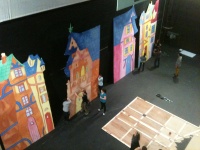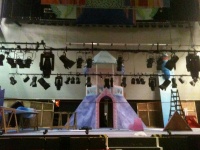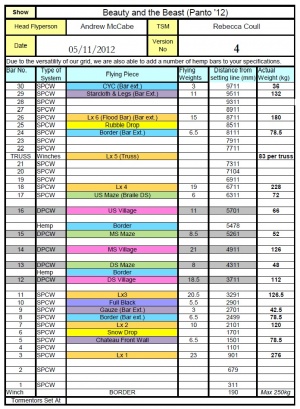Beauty and the Beast Panto 2012: Difference between revisions
| Line 186: | Line 186: | ||
'''Provisional Kit List''' | |||
'''Cabled Microphones''' | '''Cabled Microphones''' | ||
Revision as of 13:58, 2 February 2013
| Beauty and the Beast Panto 2012 | ||||||||||||||||||
|---|---|---|---|---|---|---|---|---|---|---|---|---|---|---|---|---|---|---|
Beauty and the Beast
| ||||||||||||||||||
Story
When he mocks the advances of beautiful Madame DeTestable, Sasha, the selfish and arrogant Marquis, is transformed into a hideous beast, and only has until the first snowfall of winter to make the plain Belle Atiseau declare her love for him … or he will remain a beast forever. As he hides in his chateau, his servants, Michel and Michelle bring Belle to work for him, and do their best to make him change his arrogant ways. However, Madame DeTestable - with her hapless son, Marcel - have plans to destroy the chateau and everyone in it. But Belle is not alone! With her in the chateau is her bumbling papa, Monsieur Atiseau, her tomboy best pal, Bibi, and Bibi’s mum - the brash, loud and sometimes rude, Bette Bouffant – the woman with the biggest bouffant in all France! Will Madame DeTestable manage to destroy the chateau and all in it? Will Sasha be able to change his ways to make Belle fall for him in time? And will Monsieur Atiseau ever notice Bette’s buffed-up bouffant?
Crew
- Production Manager - Sandy McRobbie (staff)
- Stage Manager - Amber McClelland
- Deputy Stage Manager - Alice McKay
- Assistant Stage Managers - Elleanor Taylor + Julia Perez
- Technical Stage Manager - Rebecca Coull
- Deputy Technical Stage Manager - Andrew McCabe
- Chief Production Electrician - Neil Foulis
- Deputy Production Electrician - Michael Parkin
- Lighting Operator - Oliver Gorman
- Sound Number 1 - Graeme Brown
- Sound Number 2 - Audrey Wilson
- Stage Electricians - Patrick Watson
- Stage Crew - Second year Designers
- Fit up Crew - First Year PTM Students
- Crew Cheif - Kev Murray
Fit Up Images
Technical Stage Management
Overview
Stage Plans
Masking

Wings
The masking for the panto required that the wings be completely masked, yet quickly and safely accessible for large numbers of cast and large props (e.g. Hairdresser’s chair, sweetie truck); the stage also had to remain quite open.
This was achieved using 4 pairs of doglegs (see Masking plan) the frames were pulled out on hemp lines to the grid and the 4x12 legs tied on. Importantly the dog legs were only tied onstage far enough to mask the entrances and the excess was doubled back.
(Note: There are only 6 dog leg frames in stock – we constructed 2 extra, using scaff and key clamps)
Borders
5 Borders were used for this performance
- Winch Bar – 16x5m
- CW8 – 16x5m (with 1.8m Bar extensions)
- Hemp Bar between CW12 and CW13 – 12.2x3m (On scaff bar made up of two of the 6.4m lengths joined with long key clamp)
- Hemp Bar between CW15 and CW16 – 16x5m (On scaff bar made up to 14m using 3 scaff lengths and two long key clamps)
- CW24 – 16x5m (with 1.8m bar extensions)
All Borders are conduited
Masking Notes
A single 4x8 hard masker (covered in a large piece of black serge tat) was propped up using a stage brace and stage weight. This was to mask the offstage entrance into the USL tower when the door in the tower was used as an entrance and exit offstage. It was placed tight against the tower behind the 3rd soft dogleg masking.
The entrance behind the Door USC in the main tower had a black tat curtain behind it to mask any light spill from void entrance or platform ladder safety lamp.
A 10x3m border was tied along the back of the pit-lift to mask off the main area of the pit and the trap entrance there.
Notable Set Elements
Dungeon Trap and Walk up Treads
A trap was used DSC during the final scene of Act 1; the performer came up from underneath it. It had a standard trap door which was pushed open from below, however under this there was a metal grill as this was supposed to be the entrance to the “Dungeon”. To open it the performer below had to push up through the grill and heave the top door open (the direction then had another cast member pulling open the grill) as this was a bit of a tricky manoeuvre, the cast member was given plenty of time to practice and become comfortable.
Below the trap the walk up treads were used with the long section from the trap down to a 8x4 steeldeck on 982mm legs and down from this the short set of corresponding treads . This was installed by Construction.
Folding Towers
There were three towers in the set which trucked on the stage and folded or unfolded for different scenes.
The tall 5 sided tower set USR opened up into the “Hall”, it was moved by 2 cast members and 1 crew member in costume, to open it was rotated to CS and then opened from there. It was refolded with a cast member inside, so a handle was added by the door to aid his balance.
The 2 DS towers started off as the Chateau Gates with two flown sections completing the “wall”, these were then flown out and the towers folded and taken to each side of the stage, these towers were more tricky to manoeuvre as while they were shorter that the USR Tower, they were heavier and bulkier, also to create the desired effect they had to move together, so required plenty of practice was required. The towers were moved by 1 crew member and 2 cast members to each tower. For the Maze scene in Act 2 the towers were rotated to reveal one side which was painted to look like part of the maze setting.
Flown Elements
Automated Truss
There were two 4m pieces of square truss that were flown on the Automation winches; these were to fly in during the show at different angles for lighting effects.
The Points are from SR to SL (7600,-4200), (7600,-800), (7360,800) & (7360,4200). (Up CL, SR-SL)
The two sections of truss sat upstage above the Chateau, all four winches were required to create the desired effect during flying. However the winches could only sit side by side in the centre section of the grid; as such the truss was slightly staggered in order to fit the winches in. The automation lines ran straight down to the truss and were attached onto the truss by a short strop and the wedge socket. The automation was operated from the flyfloor with a direct line of sight to it from there.
Snow Drop
During the “Chateau Crumble” scene the director requested rubble to fall from above the castle into the archways on either side of the main Chateau tower. To do this we rigged 4 buckets on 2 trapeze bars (to allow easy resetting – the counterweight bar could not come into a working height due to the tower); from the base of these buckets we ran lines up to the counterweight bar and off to the nearest flyfloor. When these lines were pulled, the buckets tipped and the lightweight “rubble” fell out.
Equipment Required
- x4 Plastic Buckets
- x2 long (12m) lengths of sash
- x10 short (1m) lengths of sash
- x6 small pulleys
- Cable ties
- x4 6m drifts
- x2 1m (roughly) aluminium scaff pipes
- x8 barrel clamps
- x8 1 tonne shackles
- Enough “rubble” to fill all four buckets (stage management source/make)
"Castle Crumble"
Rubble Drop
Pit Bridge
Access was required from the stage straight into the auditorium; as such we put in a pit bridge.
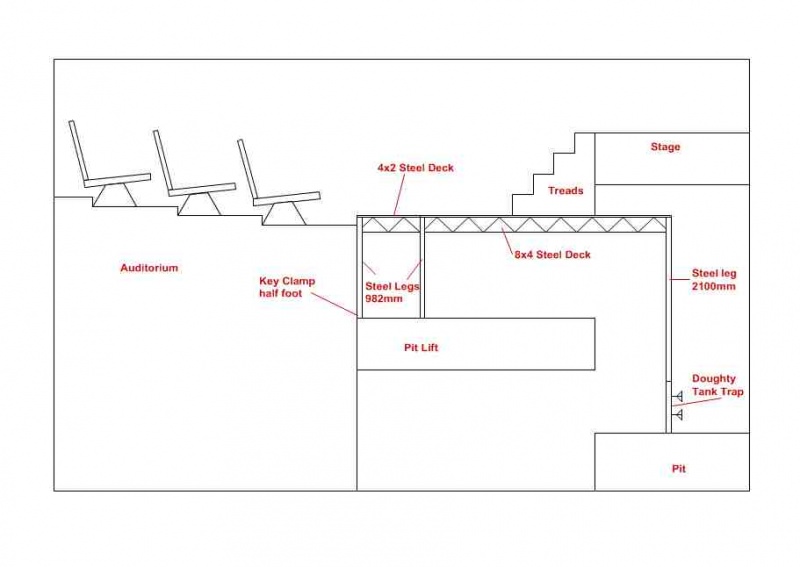
Equipment Used
- x1 8x4 Steel deck
- x14x2 steel deck
- x4 982mm scaff legs
- x2 2100mm scaff legs
- x2 Doughty tank Traps
- x2 Half key clamp feet
- x1 4 step treads (1220 tread width)
- x4 Hinges (to attach treads to front of stage and to Steel deck)
- x2 M10 Bolts and nuts
Electrics
Sound
Provisional Kit List
Cabled Microphones
- 2 x Sennheiser e614 Condenser Mic + clip
- Shure SM57 Dynamic Mic + clip
- Audix D6 Bass Mic
- Shure SM81 Condenser Mic + clip
- D112 Kick Drum Mic + clip
- Shure Beta 57-A Vocal/Instrument Dynamic Mic + clip
- 2 x Sennheiser e604 Drum Dynamic Mic + drum clip
- 3 x Shure SM57 Dynamic Mic + clip
- Shure SM58 Dynamic Mic + clip
- Shure SM58 Vocal Dynamic Mic + clip
DI's
- BSS DI Box 90
- 2 x Behringer Ultra-DI 20
Radio Beltpack Transmitters
- Shure UR1 (BP1)
- Shure UR1 (BP2)
- Shure UR1 (BP3)
- Shure UR1 (BP4)
- Shure UR1 (BP5)
- Shure UR1 (BP6)
- Shure UR1 (BP7)
- Shure UR1M (BP19)
- Shure UR1M (BP20)
- Shure UR1M (BP21)
Band Monitors
- 2 x D&b Audiotechnik MAX 12
- 2 x Mackie
Mic Stands
- Hybrid Short Boom Stand
- K&M Short Boom Stand
- K&M Short Boom Stand
- K&M Short Boom Stand
- Straight Mic Stand
- K&M Long Boom Stand
- K&M Long Boom Stand
- K&M Long Boom Stand
Stage Management
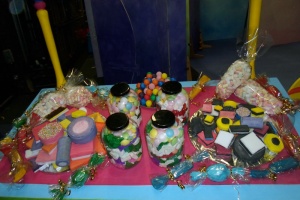
Stage Management were given a model display from the Designer of a sweetie cart and our job was to recreate this. Using cellophane we made sweetie bags which were filled with real sweets, plastic sweetie jars were sourced from TKMAxx filled with sweets also. Two wooden circles were cut and covered with tin foil creating a plate effect. Liquorice Allsorts and Dolly Mictures were made from foam,painted and glued together using a glue gun which worked very well and was used for repairs too. This sweetie cart had a raked surface which meant we needed to find a suitable way to attach the sweets, using liquid latex and carpet underlay we successfully secured the sweets. All made sweets, loose sweets around the cart and jars survived the show. They are now stored up at SLS props store.

